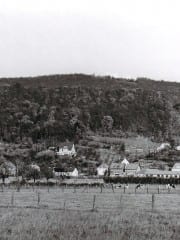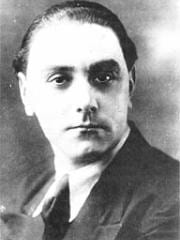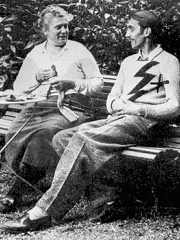Heinrich Himmler
Himmler und der Heilige Gral
Der Heilige Gral gilt seit Jahrhunderten als Reliquie, die Lebenskraft spendet. Der Verbleib des Grals gibt immer wieder den Anstoß zu vielfältigen Mythen. Auch die Nazis haben ihn gesucht. 1935 wurde der Schriftsteller Otto Rahn nach Berlin beordert. Er bekam von Heinrich Himmler den Auftrag, den Heiligen Gral zu suchen. Er sollte von der SS ausgestellt werden. Otto Rahn musste seine jahrelange Suche am Ende mit dem Leben bezahlen.
Interview with Jeanne D'Aout: New book with Otto is out
Q: It’s nice to meet you again. Congratulations on your new book!
The new book, The Eye of Ra, also features Otto Rahn. I know every new book is always a breakthrough for a real writer. What was your main finding?
A: My most important discovery while writing my second book, ‘The Eye of Ra’, is the incredible experience of having lots of questions and finding out as soon as I started writing, that I had the answers already within me. Writing activates something in the brain that helps you understand certain things that are normally difficult to understand. Writing ‘The Eye of Ra’ took me back to ancient Egypt, where I set myself the quest of discovering the identity of the Biblical divination stones known as the Urim and Thummim, and to understand the psyche behind the heretical Pharaoh Akhenaten.
White Lie by Jeanne D'Aout, scene with Otto
“The nightmare was complete when I couldn’t even prove I was a pure blood Aryan, because when I researched my genealogy, I realised my mother and maternal grandfather were Jewish. And I must admit, I was a trouble-maker, I got into fights a lot when I saw SS soldiers misbehave and I wanted to make a career, to move further up the ladder. I was attracted by the power of my superiors, like many others, and in this process I gained a few political enemies. This is how my reputation attracted Hitler’s attention. He demanded my presence at the Berghof, Hitler’s base near Bergtesgaden on the German-Austrian border. I can still remember him, sitting behind his desk, wearing his reading glasses while reading my file. I had never seen him with reading glasses before. While Hitler was reading my file I waited for his reaction. My legs nearly gave way. Then he gave me my new orders, which said that I was drafted to be trained as a soldier, “to make a man out of me”, he said, so I took the journey to Buchenwald…”
Otto started to tremble again.
Otto Rahn y la Búsqueda Nazi por el Secreto de los Cátaros
La Berlin de entreguerras era una ciudad conocida en toda Europa por su sub-cultura bohemia y sus jovenes intelectuales. Entre los personajes que ardientemente celebraban los abundantes «ismos» que estaban fracturando las viejas certezas ideologicas, las cuales habian compactado el siglo XIX, pocos individuos eran mas coloridos que un joven de ojos verdes y cabellos oscuros llamado Otto Rahn. Su figura delgada, envuelta en un caracteristico abrigo negro y sombrero tiroles, arrojaba una larga sombra desde esos anos sombrios, una «gran silueta» alrededor de la cual se han acumulado los mitos mas extravagantes. El fue considerado igualmente como mason, rosacruz, luciferino, y un agente de la Sociedad Thule. Como lo plantea el autor Phillip Kerr, los contemporaneos de Rahn no se habrian sorprendido de ver «la Dama Escarlata y la Gran Bestia salir volando desde la puerta del frente» de su apartamento en Tiergartenstrasse. Uno de sus companeros de la Orden Negra de Heinrich Himmler comento en un memorandum interno que el «medio sospechaba que Rahn tenia relaciones con el pueblo pequeno».
В поисках утраченного Грааля
Берлин между мировыми войнами был городом, известным по всей Европе своей богемной субкультурой молодых интеллектуалов. Среди лиц, которые горячо обсуждали много модернистских "измов", которые ломали старые идеологические определения, что склеивали 19-ое столетие, немногие были более колоритными, чем этот темноволосый, зеленоглазый молодой человек по имени Отто Вильгельм Ран. Его худая фигура, одетая в характерный черный плащ и фетровую шляпу, бросает длинную тень из тех сумеречных лет, ‘великий силуэт’, вокруг которого вращались самые невероятные мифы. Он, как говорили, был Масоном, Розенкрейцером, Люциферианцем, посланцем Общества Туле, посвященным Катаром и даже руководителем некоего неизвестного международного тайного общества.
Lachrymae, Chapter IV: The Final Chapter
An Online Journal by Richard Stanley<
(Originally appeared in R. S.' MySpace<, December 9th, 2007.)
Brethren, I have invited you here to this ancient, invisible theatre with the intention of not only unmasking the killer God responsible for these crimes against 'reality', but more cogently, to provide an unambiguous solution to two or perhaps three long running esoteric enigmas!
I salute those who have stayed with the program from the top. For late joiners I include an index to conjure order out of the scrolling chaos and serve as an aid memoir for those hardy few who dare read further. I have very little keyboard time at present and less in the months to come. Until we meet again this strange saga is my gift to you.
Be warned the completed text contains 'spoilers' and may be hazardous to your belief systems.
Otto Rahn Memorial Website interview with Jeanne D'Août, the Author of White Lie
Hi, Jeanne!
I congratulate you on the release of your book White Lie. This is a great event for all who are familiar with the work, searching and life of Otto Wilhelm Rahn. When did you first hear of him?
Jeanne:
The first time I heard of Otto Rahn was probably during my research of the history of Montségur and the Cathars in connection with Grail lore. I never studied the man himself and only knew what most people know; that he researched Grail lore, visited Montségur and was working for Himmler as a relic hunter in a pre-war Germany. It wasn't until 2008 that a friend sent me "Crusade against the Grail" in English, followed by "Lucifer's Court" and Nigel Graddon's "Otto Rahn, Quest for the Holy Grail". I was thinking of writing a thriller book at that time about the 1st century, and the mysteries of the Languedoc. I had already done a lot of research for the book, but didn't get around to actually writing it, because the financial crisis had made me and my husband work 7 days a week to make a living. In 2011 I first had the chance to sit down properly and started writing in January. I would write almost 18 to 20 hours a day for several months and Otto slowly became one of the key players in the book.
Русское предисловие к книге Рене Нелли "Катары. Святые еретики"
Ученый францисканец Вильгельм Баскервильский в романе Умберто Эко «Имя розы» объясняет своему ученику Адсону наличие огромного количества ересей и сект, которые порой непросто отличить друг от друга, следующим образом: «Представь себе... реку, мощную, полноводную реку, которая течет тысячи и тысячи верст в своем крепком русле, и ты, ее видя, в точности можешь сказать, где река, где берег, где - твердая земля. Однако в какое-то время, в каком-то месте эта река попросту устает течь — возможно из-за того, что течет она слишком долго и слишком издалека, возможно из-за того, что уже близится море, а море вбирает в себя любые, самые могучие реки, и таким образом любые, самые могучие реки перестают существовать. И река превращается в дельту.
Otto Rahn: las conexiones entre catarismo y nazismo
UNA DE LAS FIGURAS que más fascinación ha ejercido en relación al mundo “neocátaro” es Otto Rahn, que buscó el Santo Grial en la fortaleza de Montségur. Miembro de las SS que acabó expulsado de sus filas, dejó una obra escrita breve pero influyente en el entorno hitleriano al amalgamar nazismo y catarismo. Sabemos muy poco de él, pues su trayectoria está rodeada de toda suerte de especulaciones. Y es que su personalidad fue harto chocante: francófilo y al parecer homosexual, se desenvolvió en un universo nazi pangermánico y exaltador de la virilidad.
Así las cosas, los interrogantes sobre Rahn son numerosos, abarcan todos los órdenes de su vida y tienen difícil respuesta con las fuentes disponibles: ¿Fue un estudioso del catarismo o lo empleó como pretexto para labores de espionaje? ¿Actuó como un nazi convencido o su condición de homosexual y la falta de medios le llevaron a las filas de las SS? ¿Murió en 1939 o se orquestó una farsa para “blanquear” sus supuestos ancestros judíos? Al margen de sus móviles, sabemos con certeza que nazificó el catarismo y mereció la atención y la complacencia del máximo dirigente de las SS, Heinrich Himmler.








Commenti recenti
13 anni 44 settimane fa
13 anni 45 settimane fa
13 anni 45 settimane fa
13 anni 45 settimane fa
13 anni 48 settimane fa
14 anni 2 settimane fa